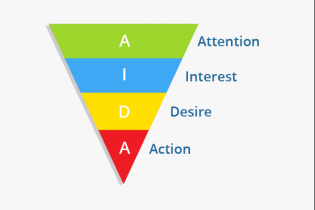By Sajeeb Sarker
AIDA Model
Media School June 24, 2020

AIDA model has been in use for over 100 years. Image source: en.ryte.com
AIDA actually is an acronym that stands for: Attention, Interest, Desire and Action. This model explains the usual steps customers gradually go through before making a purchase finally.
Highly applied in Advertising and Marketing areas along with others, this model briefly but efficiently describes the steps of the usual process of purchasing. After it was introduced in the late 19th century, this model has been widely used, analyzed and modified multiple times over the years especially in the fields of Marketing and Public Relations.
The AIDA model was developed by E. St. Elmo Lewis, an American businessman who introduced it in 1898 primarily with the purpose to optimize specifically the interaction between seller and buyer. Being simple but effective, the AIDA model is widely used in digital marketing, sales strategies, and public relations campaigns ever since.
Now, if we look at the four stages the AIDA model explains in regard to purchasing or making a choice for such purpose:
1. Attract 'Attention': The first stage is that the product or service must attract the potential consumer's attention. This is performed by means of the advertising materials. This is referred as an 'eye-catcher'. This is like 'Ok, now I know of it' for the customer.
2. Maintain 'Interest': The attention of any potential customer is grabbed in the first phase. And once the consumer is aware that the particular product or service exists in the market, then is the time to develop the potential customer’s interest in that product or service. This phase makes the customer feel: 'I like it'.
3. Create 'Desire': After interest is aroused, now is the time to persuade or convince the customer that s/he wants or needs to have this product or service. In this case, customers' emotions are usually manipulated in doing so. This phase turns 'I like it' to 'I want it'.
4. Take 'Action': Only creating a desire to purchase is not enough; that desire must be driven positively so that it is transferred into an action: the purchase. This is like: 'I am going to get it now.'
AIDA is often referred to as a communication model rather than a decision-making model. It is because this model is all about how and when to communicate during each of the stages.
Criticism
The AIDA model has long been viewed as commendable in regard to successful sales process. It has been credited to shaping the core views on marketing and sales since its introduction. AIDA has also been efficiently used in PR for planning and analyzing the effectiveness of PR strategies and/or campaigns. It is also significant till today in the field of advertising especially in regard to develop and/or analyze the messages.
But beyond that some arguments also paved their way as well regarding the effectiveness of the AIDA model as the marketing and sales processes became more complex day by day.
Main criticism of AIDA is that this is a linear and excessively simple model that is no longer fully capable of explaining today's (modern) complex marketing or sales promotion process.
A major weakness of the AIDA model is that it does not address the post-purchase effects (i.e. satisfaction or consumption) that are important for getting actual 'feedback'.
Another criticism of this model is its dependence on a hierarchical sequence of a linear nature. Empirical studies found AIDA model as a poor predictor of actual consumer behavior.
Another major criticism of AIDA is that this model suggests a step-by-step model in a fixed sequence which is not always the scenario in all cases.
It is also claimed that this model does not recognize or address the advertising psychology that is extremely crucial in this field. Also, this model does not include any scope for considering the socio-demographic background of the buyers that is another important factor while devising any promotional campaigns.
Also, online business that is selling and buying on online platforms is getting more and more predominant. Online business has distinguished and significant issues of its own which the AIDA model, also, does not take into account.
Valuable readings:
Lewis, E. St Elmo (1908). Financial Advertising (The History of Advertising), USA, Levey Brothers.
Priyanka, R (2013). "AIDA Marketing Communication Model: Stimulating a purchase decision in the minds of the consumers through a linear progression of steps". International Journal of Multidisciplinary Research in Social Managemen., Vol. 1 .
Bendizlen, M.T. “Advertising Effects and Effectiveness”. European Journal of Marketing. Vol. 27, No. 10.
Vakratsas, Demetrios & Ambler Tim (1999). "How Advertising Works: What Do We Really Know?" Journal of Marketing. Vol. 63, No. 1.
Kitson, H.S. (1920). Manual for the Study of the Psychology of Advertising and Selling. Philadelphia.


